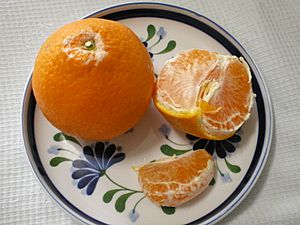Kiyomi facts for kids
Quick facts for kids Kiyomi |
|
|---|---|

Kiyomi
|
|
| Genus | Citrus |
| Hybrid parentage | C. unshiu × sinensis |
| Origin | Japan |
Kiyomi (清見, kiyomi) is a special type of citrus fruit from Japan. It's a mix, or hybrid, of two other fruits: a Miyagawa Wase mikan (which is like a small, easy-to-peel orange) and a regular orange.
This new fruit was the very first tangor ever created in Japan. A tangor is a hybrid fruit made by crossing a tangerine or mikan with an orange. Kiyomi was developed in 1949. It got its name from a temple called Seiken-ji (清見寺) and a lagoon called Kiyomi-gata (清見潟), which are both near the research station in Shizuoka city where it was created. It was officially registered as a new fruit in 1979.
What Makes Kiyomi Special?
Kiyomi fruits are known for being very sweet. Their sugar level, measured in °Bx, is usually between 11 and 12. Sometimes, if the growing conditions are perfect, it can even reach 13°Bx! This means they are super tasty.
They also have a small amount of Citric acid, which is what gives fruits their tart or sour taste, usually around 1%. This balance of sweet and a little bit of tart makes them delicious. Kiyomi fruits also have no seeds, which makes them easy to eat.
They are ready to be picked and enjoyed in the middle to late part of March. When you taste a Kiyomi, it has a flavor similar to a mikan, but its smell is more like a regular orange.
How Kiyomi Helps Create New Fruits
Kiyomi is a "monogerm" fruit. This means that its seeds (if it had any, though Kiyomi usually doesn't) would only produce one plant, and that plant would be exactly like the parent plant. This makes Kiyomi very useful for scientists who want to create new types of citrus fruits.
Because it's so reliable, Kiyomi is often used as a "parent" fruit to make exciting new hybrids. A famous example of a fruit created using Kiyomi as a parent is the dekopon, which is another popular Japanese citrus fruit known for its unique bump on top.

